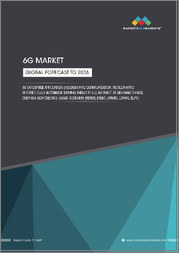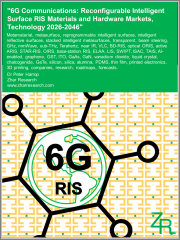
|
시장보고서
상품코드
1770840
6G 시장 - 세계 산업 규모, 점유율, 동향, 기회, 예측 : 경쟁별, 통신 인프라별, 용도별, 최종사용자별, 지역별, 경쟁별(2020-2030년)6G Market - Global Industry Size, Share, Trends, Opportunity, and Forecast, By Component, By Communication Infrastructure, By Application, By End User, By Region & Competition, 2020-2030F |
||||||
6G 세계 시장 규모는 2024년에 64억 3,000만 달러, 2030년에는 203억 8,000만 달러에 달하고, 예측 기간 동안 CAGR 21.20%로 성장할 것으로 예측됩니다.
무선 기술의 다음 단계인 6G는 2030년경 5G의 뒤를 이을 것으로 예상되며, 최대 1테라비트/초의 전례 없는 데이터 속도, 초저지연, 강력한 연결성을 실현하는 것을 목표로 합니다. 양자 네트워킹, 자율 시스템, 홀로그램 통신과 같은 첨단 애플리케이션을 지원하고 물리적, 디지털, 생물학적 영역을 통합하며, 5G와 달리 6G는 AI와 엣지 컴퓨팅을 활용하고 인간과 기계 간의 통신을 위해 설계되었습니다. 미국, 중국, 한국, 유럽 등 주요 국가들은 막대한 투자와 세계 협력을 통해 5G의 연구개발을 주도하고 있습니다. 주요 사용 사례는 스마트 시티, 산업 자동화, 자율주행차, 몰입형 AR/VR에 이르기까지 다양하며, 국방, 헬스케어, 원격 조작 등의 분야에서 수요가 증가하고 있어 도입이 더욱 가속화되고 있습니다.
| 시장 개요 | |
|---|---|
| 예측 기간 | 2026-2030년 |
| 시장 규모 : 2024년 | 64억 3,000만 달러 |
| 시장 규모 : 2030년 | 203억 8,000만 달러 |
| CAGR : 2025-2030년 | 21.20% |
| 급성장 부문 | 커넥티드·로보틱스와 자율 시스템 |
| 최대 시장 | 북미 |
시장 촉진요인
몰입형 애플리케이션을 위한 초광대역폭 요구
주요 시장 과제
스펙트럼 할당 및 인프라 준비
주요 시장 동향
네트워크 아키텍처에 인공지능 통합
목차
제1장 솔루션 개요
- 시장 정의
- 시장 범위
- 대상 시장
- 조사 대상 연도
- 주요 시장 세분화
제2장 조사 방법
제3장 주요 요약
제4장 고객의 소리
제5장 세계의 6G 시장 전망
- 시장 규모 및 예측
- 금액별
- 시장 점유율과 예측
- 구성요소별(하드웨어, 소프트웨어, 서비스)
- 통신 인프라별(무선, 고정)
- 용도별(다감각 XR 애플리케이션, 커넥티드 로보틱스 및 자율 시스템, 무선 브레인 컴퓨터 인터랙션, 디지털 트윈, 스마트 시티, 모든 것 인터넷(IoE), 블록체인 및 DLT, 기타)
- 최종사용자별(정부, 소비자, 산업, 기업, 기타)
- 지역별(북미, 유럽, 남미, 중동 및 아프리카, 아시아태평양)
- 기업별(2024)
- 시장 맵
제6장 북미의 6G 시장 전망
- 시장 규모 및 예측
- 시장 점유율과 예측
- 북미 : 국가별 분석
- 미국
- 캐나다
- 멕시코
제7장 유럽의 6G 시장 전망
- 시장 규모 및 예측
- 시장 점유율과 예측
- 유럽 : 국가별 분석
- 독일
- 프랑스
- 영국
- 이탈리아
- 스페인
제8장 아시아태평양의 6G 시장 전망
- 시장 규모 및 예측
- 시장 점유율과 예측
- 아시아태평양 : 국가별 분석
- 중국
- 인도
- 일본
- 한국
- 호주
제9장 중동 및 아프리카의 6G 시장 전망
- 시장 규모 및 예측
- 시장 점유율과 예측
- 중동 및 아프리카 : 국가별 분석
- 사우디아라비아
- 아랍에미리트
- 남아프리카공화국
제10장 남미의 6G 시장 전망
- 시장 규모 및 예측
- 시장 점유율과 예측
- 남미 : 국가별 분석
- 브라질
- 콜롬비아
- 아르헨티나
제11장 시장 역학
- 성장 촉진요인
- 과제
제12장 시장 동향과 발전
- 인수합병
- 제품 출시
- 최근 동향
제13장 기업 개요
- Samsung Electronics Co., Ltd.
- Huawei Technologies Co., Ltd.
- Nokia Corporation
- Telefonaktiebolaget LM Ericsson
- Qualcomm Incorporated
- ZTE Corporation
- Intel Corporation
- NEC Corporation
제14장 전략적 제안
제15장 조사 회사 소개 및 면책사항
ksm 25.07.18The Global 6G Market was valued at USD 6.43 billion in 2024 and is projected to reach USD 20.38 billion by 2030, growing at a CAGR of 21.20% through the forecast period. Representing the next frontier in wireless technology, 6G is expected to succeed 5G around 2030 and aims to deliver unprecedented data speeds of up to 1 terabit per second, ultra-low latency, and robust connectivity. It will support advanced applications such as quantum networking, autonomous systems, and holographic communications, integrating physical, digital, and biological realms. Unlike 5G, 6G is designed for both human and machine communications, leveraging AI and edge computing. Countries like the U.S., China, South Korea, and key European nations are leading the charge in 6G R&D through significant investments and global collaborations. Key use cases span smart cities, industrial automation, autonomous vehicles, and immersive AR/VR, with rising demand from sectors like defense, healthcare, and remote operations further accelerating adoption.
| Market Overview | |
|---|---|
| Forecast Period | 2026-2030 |
| Market Size 2024 | USD 6.43 Billion |
| Market Size 2030 | USD 20.38 Billion |
| CAGR 2025-2030 | 21.20% |
| Fastest Growing Segment | Connected Robotics and Autonomous Systems |
| Largest Market | North America |
Key Market Drivers
Ultra High Bandwidth Demand for Immersive Applications
The surge in demand for immersive, data-intensive applications such as augmented reality, holographic telepresence, and virtual collaboration is driving the need for ultra-high bandwidth. Enterprises are embedding these technologies into operations, remote collaboration, and hybrid workflows. For example, telemedicine using real-time 3D imagery or multinational firms hosting virtual facility tours require network speeds beyond 5G's capabilities. 6G's promise of terabit-level data rates will facilitate reliable streaming of volumetric content and lifelike virtual experiences. This advancement presents new monetization opportunities for telecom operators through premium connectivity and enterprise-grade solutions.
Key Market Challenges
Spectrum Allocation and Infrastructure Readiness
A major hurdle for the global 6G market is the allocation and regulation of suitable spectrum, particularly within the terahertz (THz) bands. Unlike prior generations that operated in sub-6 GHz and millimeter-wave frequencies, 6G will use 100 GHz to 3 THz bands, which are prone to atmospheric interference and require line-of-sight for transmission. These bands currently lack a cohesive global regulatory framework. Collaborative efforts among governments, regulators, and entities like the International Telecommunication Union (ITU) are essential for harmonizing spectrum use. Without unified standards, global interoperability could suffer, delaying device development and deployment timelines. Navigating this complex regulatory landscape will necessitate extended negotiations and may postpone commercial rollout beyond 2030.
Key Market Trends
Integration of Artificial Intelligence into Network Architecture
One of the most prominent trends in the 6G landscape is the deep-rooted integration of artificial intelligence and machine learning into the network's core. Unlike prior networks where AI functioned peripherally, 6G will embed intelligence at every level-from design and traffic optimization to autonomous network configuration and personalized services. AI-driven systems will handle dynamic spectrum management, adaptive beamforming, and predictive maintenance, enhancing speed, reducing latency, and improving energy efficiency in dense urban settings. Additionally, 6G's AI-native design will support tailored network slicing for different industries, ensuring optimal performance for sectors such as autonomous transport and healthcare. Investments in technologies like federated learning and edge inference are already underway, reflecting a significant shift in how telecom networks will be designed, operated, and monetized in the future.
Key Market Players
- Samsung Electronics Co., Ltd.
- Huawei Technologies Co., Ltd.
- Nokia Corporation
- Telefonaktiebolaget LM Ericsson
- Qualcomm Incorporated
- ZTE Corporation
- Intel Corporation
- NEC Corporation
Report Scope:
In this report, the Global 6G Market has been segmented into the following categories, in addition to the industry trends which have also been detailed below:
6G Market, By Component:
- Hardware
- Software
- Services
6G Market, By Communication Infrastructure:
- Wireless
- Fixed
6G Market, By Application:
- Multisensory XR Applications
- Connected Robotics and Autonomous Systems
- Wireless Brain-Computer Interactions
- Digital Twins
- Smart Cities
- Internet of Everything (IoE)
- Blockchain and DLT
- Others
6G Market, By End User:
- Government
- Consumer
- Industrial
- Enterprise
- Others
6G Market, By Region:
- North America
- United States
- Canada
- Mexico
- Europe
- Germany
- France
- United Kingdom
- Italy
- Spain
- Asia Pacific
- China
- India
- Japan
- South Korea
- Australia
- Middle East & Africa
- Saudi Arabia
- UAE
- South Africa
- South America
- Brazil
- Colombia
- Argentina
Competitive Landscape
Company Profiles: Detailed analysis of the major companies present in the Global 6G Market.
Available Customizations:
Global 6G Market report with the given market data, TechSci Research offers customizations according to a company's specific needs. The following customization options are available for the report:
Company Information
- Detailed analysis and profiling of additional market players (up to five).
Table of Contents
1. Solution Overview
- 1.1. Market Definition
- 1.2. Scope of the Market
- 1.2.1. Markets Covered
- 1.2.2. Years Considered for Study
- 1.2.3. Key Market Segmentations
2. Research Methodology
- 2.1. Objective of the Study
- 2.2. Baseline Methodology
- 2.3. Key Industry Partners
- 2.4. Major Association and Secondary Sources
- 2.5. Forecasting Methodology
- 2.6. Data Triangulation & Validation
- 2.7. Assumptions and Limitations
3. Executive Summary
- 3.1. Overview of the Market
- 3.2. Overview of Key Market Segmentations
- 3.3. Overview of Key Market Players
- 3.4. Overview of Key Regions/Countries
- 3.5. Overview of Market Drivers, Challenges, and Trends
4. Voice of Customer
5. Global 6G Market Outlook
- 5.1. Market Size & Forecast
- 5.1.1. By Value
- 5.2. Market Share & Forecast
- 5.2.1. By Component (Hardware, Software, Services)
- 5.2.2. By Communication Infrastructure (Wireless, Fixed)
- 5.2.3. By Application (Multisensory XR Applications, Connected Robotics and Autonomous Systems, Wireless Brain-Computer Interactions, Digital Twins, Smart Cities, Internet of Everything (IoE), Blockchain and DLT, Others)
- 5.2.4. By End User (Government, Consumer, Industrial, Enterprise, Others)
- 5.2.5. By Region (North America, Europe, South America, Middle East & Africa, Asia Pacific)
- 5.3. By Company (2024)
- 5.4. Market Map
6. North America 6G Market Outlook
- 6.1. Market Size & Forecast
- 6.1.1. By Value
- 6.2. Market Share & Forecast
- 6.2.1. By Component
- 6.2.2. By Communication Infrastructure
- 6.2.3. By Application
- 6.2.4. By End User
- 6.2.5. By Country
- 6.3. North America: Country Analysis
- 6.3.1. United States 6G Market Outlook
- 6.3.1.1. Market Size & Forecast
- 6.3.1.1.1. By Value
- 6.3.1.2. Market Share & Forecast
- 6.3.1.2.1. By Component
- 6.3.1.2.2. By Communication Infrastructure
- 6.3.1.2.3. By Application
- 6.3.1.2.4. By End User
- 6.3.1.1. Market Size & Forecast
- 6.3.2. Canada 6G Market Outlook
- 6.3.2.1. Market Size & Forecast
- 6.3.2.1.1. By Value
- 6.3.2.2. Market Share & Forecast
- 6.3.2.2.1. By Component
- 6.3.2.2.2. By Communication Infrastructure
- 6.3.2.2.3. By Application
- 6.3.2.2.4. By End User
- 6.3.2.1. Market Size & Forecast
- 6.3.3. Mexico 6G Market Outlook
- 6.3.3.1. Market Size & Forecast
- 6.3.3.1.1. By Value
- 6.3.3.2. Market Share & Forecast
- 6.3.3.2.1. By Component
- 6.3.3.2.2. By Communication Infrastructure
- 6.3.3.2.3. By Application
- 6.3.3.2.4. By End User
- 6.3.3.1. Market Size & Forecast
- 6.3.1. United States 6G Market Outlook
7. Europe 6G Market Outlook
- 7.1. Market Size & Forecast
- 7.1.1. By Value
- 7.2. Market Share & Forecast
- 7.2.1. By Component
- 7.2.2. By Communication Infrastructure
- 7.2.3. By Application
- 7.2.4. By End User
- 7.2.5. By Country
- 7.3. Europe: Country Analysis
- 7.3.1. Germany 6G Market Outlook
- 7.3.1.1. Market Size & Forecast
- 7.3.1.1.1. By Value
- 7.3.1.2. Market Share & Forecast
- 7.3.1.2.1. By Component
- 7.3.1.2.2. By Communication Infrastructure
- 7.3.1.2.3. By Application
- 7.3.1.2.4. By End User
- 7.3.1.1. Market Size & Forecast
- 7.3.2. France 6G Market Outlook
- 7.3.2.1. Market Size & Forecast
- 7.3.2.1.1. By Value
- 7.3.2.2. Market Share & Forecast
- 7.3.2.2.1. By Component
- 7.3.2.2.2. By Communication Infrastructure
- 7.3.2.2.3. By Application
- 7.3.2.2.4. By End User
- 7.3.2.1. Market Size & Forecast
- 7.3.3. United Kingdom 6G Market Outlook
- 7.3.3.1. Market Size & Forecast
- 7.3.3.1.1. By Value
- 7.3.3.2. Market Share & Forecast
- 7.3.3.2.1. By Component
- 7.3.3.2.2. By Communication Infrastructure
- 7.3.3.2.3. By Application
- 7.3.3.2.4. By End User
- 7.3.3.1. Market Size & Forecast
- 7.3.4. Italy 6G Market Outlook
- 7.3.4.1. Market Size & Forecast
- 7.3.4.1.1. By Value
- 7.3.4.2. Market Share & Forecast
- 7.3.4.2.1. By Component
- 7.3.4.2.2. By Communication Infrastructure
- 7.3.4.2.3. By Application
- 7.3.4.2.4. By End User
- 7.3.4.1. Market Size & Forecast
- 7.3.5. Spain 6G Market Outlook
- 7.3.5.1. Market Size & Forecast
- 7.3.5.1.1. By Value
- 7.3.5.2. Market Share & Forecast
- 7.3.5.2.1. By Component
- 7.3.5.2.2. By Communication Infrastructure
- 7.3.5.2.3. By Application
- 7.3.5.2.4. By End User
- 7.3.5.1. Market Size & Forecast
- 7.3.1. Germany 6G Market Outlook
8. Asia Pacific 6G Market Outlook
- 8.1. Market Size & Forecast
- 8.1.1. By Value
- 8.2. Market Share & Forecast
- 8.2.1. By Component
- 8.2.2. By Communication Infrastructure
- 8.2.3. By Application
- 8.2.4. By End User
- 8.2.5. By Country
- 8.3. Asia Pacific: Country Analysis
- 8.3.1. China 6G Market Outlook
- 8.3.1.1. Market Size & Forecast
- 8.3.1.1.1. By Value
- 8.3.1.2. Market Share & Forecast
- 8.3.1.2.1. By Component
- 8.3.1.2.2. By Communication Infrastructure
- 8.3.1.2.3. By Application
- 8.3.1.2.4. By End User
- 8.3.1.1. Market Size & Forecast
- 8.3.2. India 6G Market Outlook
- 8.3.2.1. Market Size & Forecast
- 8.3.2.1.1. By Value
- 8.3.2.2. Market Share & Forecast
- 8.3.2.2.1. By Component
- 8.3.2.2.2. By Communication Infrastructure
- 8.3.2.2.3. By Application
- 8.3.2.2.4. By End User
- 8.3.2.1. Market Size & Forecast
- 8.3.3. Japan 6G Market Outlook
- 8.3.3.1. Market Size & Forecast
- 8.3.3.1.1. By Value
- 8.3.3.2. Market Share & Forecast
- 8.3.3.2.1. By Component
- 8.3.3.2.2. By Communication Infrastructure
- 8.3.3.2.3. By Application
- 8.3.3.2.4. By End User
- 8.3.3.1. Market Size & Forecast
- 8.3.4. South Korea 6G Market Outlook
- 8.3.4.1. Market Size & Forecast
- 8.3.4.1.1. By Value
- 8.3.4.2. Market Share & Forecast
- 8.3.4.2.1. By Component
- 8.3.4.2.2. By Communication Infrastructure
- 8.3.4.2.3. By Application
- 8.3.4.2.4. By End User
- 8.3.4.1. Market Size & Forecast
- 8.3.5. Australia 6G Market Outlook
- 8.3.5.1. Market Size & Forecast
- 8.3.5.1.1. By Value
- 8.3.5.2. Market Share & Forecast
- 8.3.5.2.1. By Component
- 8.3.5.2.2. By Communication Infrastructure
- 8.3.5.2.3. By Application
- 8.3.5.2.4. By End User
- 8.3.5.1. Market Size & Forecast
- 8.3.1. China 6G Market Outlook
9. Middle East & Africa 6G Market Outlook
- 9.1. Market Size & Forecast
- 9.1.1. By Value
- 9.2. Market Share & Forecast
- 9.2.1. By Component
- 9.2.2. By Communication Infrastructure
- 9.2.3. By Application
- 9.2.4. By End User
- 9.2.5. By Country
- 9.3. Middle East & Africa: Country Analysis
- 9.3.1. Saudi Arabia 6G Market Outlook
- 9.3.1.1. Market Size & Forecast
- 9.3.1.1.1. By Value
- 9.3.1.2. Market Share & Forecast
- 9.3.1.2.1. By Component
- 9.3.1.2.2. By Communication Infrastructure
- 9.3.1.2.3. By Application
- 9.3.1.2.4. By End User
- 9.3.1.1. Market Size & Forecast
- 9.3.2. UAE 6G Market Outlook
- 9.3.2.1. Market Size & Forecast
- 9.3.2.1.1. By Value
- 9.3.2.2. Market Share & Forecast
- 9.3.2.2.1. By Component
- 9.3.2.2.2. By Communication Infrastructure
- 9.3.2.2.3. By Application
- 9.3.2.2.4. By End User
- 9.3.2.1. Market Size & Forecast
- 9.3.3. South Africa 6G Market Outlook
- 9.3.3.1. Market Size & Forecast
- 9.3.3.1.1. By Value
- 9.3.3.2. Market Share & Forecast
- 9.3.3.2.1. By Component
- 9.3.3.2.2. By Communication Infrastructure
- 9.3.3.2.3. By Application
- 9.3.3.2.4. By End User
- 9.3.3.1. Market Size & Forecast
- 9.3.1. Saudi Arabia 6G Market Outlook
10. South America 6G Market Outlook
- 10.1. Market Size & Forecast
- 10.1.1. By Value
- 10.2. Market Share & Forecast
- 10.2.1. By Component
- 10.2.2. By Communication Infrastructure
- 10.2.3. By Application
- 10.2.4. By End User
- 10.2.5. By Country
- 10.3. South America: Country Analysis
- 10.3.1. Brazil 6G Market Outlook
- 10.3.1.1. Market Size & Forecast
- 10.3.1.1.1. By Value
- 10.3.1.2. Market Share & Forecast
- 10.3.1.2.1. By Component
- 10.3.1.2.2. By Communication Infrastructure
- 10.3.1.2.3. By Application
- 10.3.1.2.4. By End User
- 10.3.1.1. Market Size & Forecast
- 10.3.2. Colombia 6G Market Outlook
- 10.3.2.1. Market Size & Forecast
- 10.3.2.1.1. By Value
- 10.3.2.2. Market Share & Forecast
- 10.3.2.2.1. By Component
- 10.3.2.2.2. By Communication Infrastructure
- 10.3.2.2.3. By Application
- 10.3.2.2.4. By End User
- 10.3.2.1. Market Size & Forecast
- 10.3.3. Argentina 6G Market Outlook
- 10.3.3.1. Market Size & Forecast
- 10.3.3.1.1. By Value
- 10.3.3.2. Market Share & Forecast
- 10.3.3.2.1. By Component
- 10.3.3.2.2. By Communication Infrastructure
- 10.3.3.2.3. By Application
- 10.3.3.2.4. By End User
- 10.3.3.1. Market Size & Forecast
- 10.3.1. Brazil 6G Market Outlook
11. Market Dynamics
- 11.1. Drivers
- 11.2. Challenges
12. Market Trends and Developments
- 12.1. Merger & Acquisition (If Any)
- 12.2. Product Launches (If Any)
- 12.3. Recent Developments
13. Company Profiles
- 13.1. Samsung Electronics Co., Ltd.
- 13.1.1. Business Overview
- 13.1.2. Key Revenue and Financials
- 13.1.3. Recent Developments
- 13.1.4. Key Personnel
- 13.1.5. Key Product/Services Offered
- 13.2. Huawei Technologies Co., Ltd.
- 13.3. Nokia Corporation
- 13.4. Telefonaktiebolaget LM Ericsson
- 13.5. Qualcomm Incorporated
- 13.6. ZTE Corporation
- 13.7. Intel Corporation
- 13.8. NEC Corporation
14. Strategic Recommendations
15. About Us & Disclaimer
(주말 및 공휴일 제외)


















